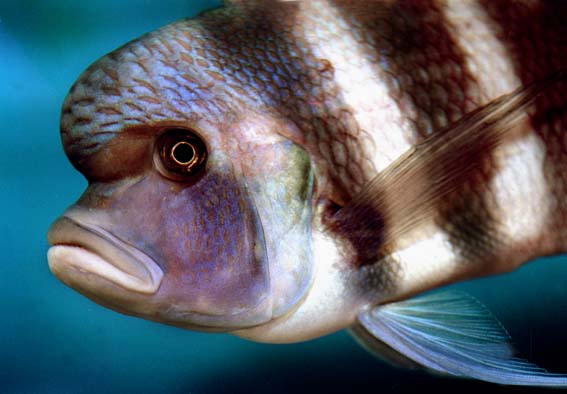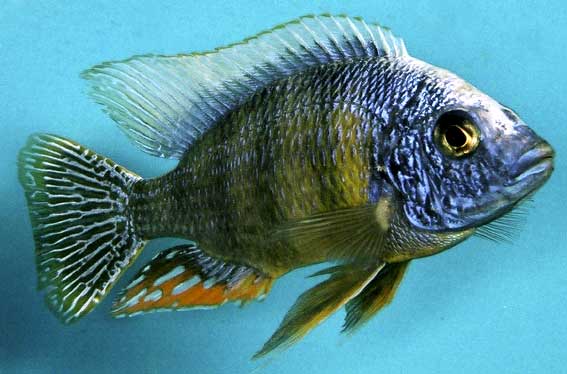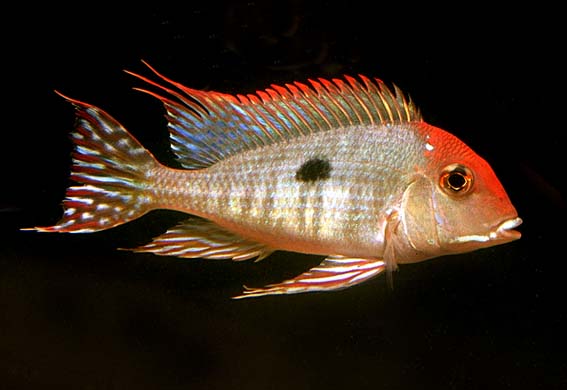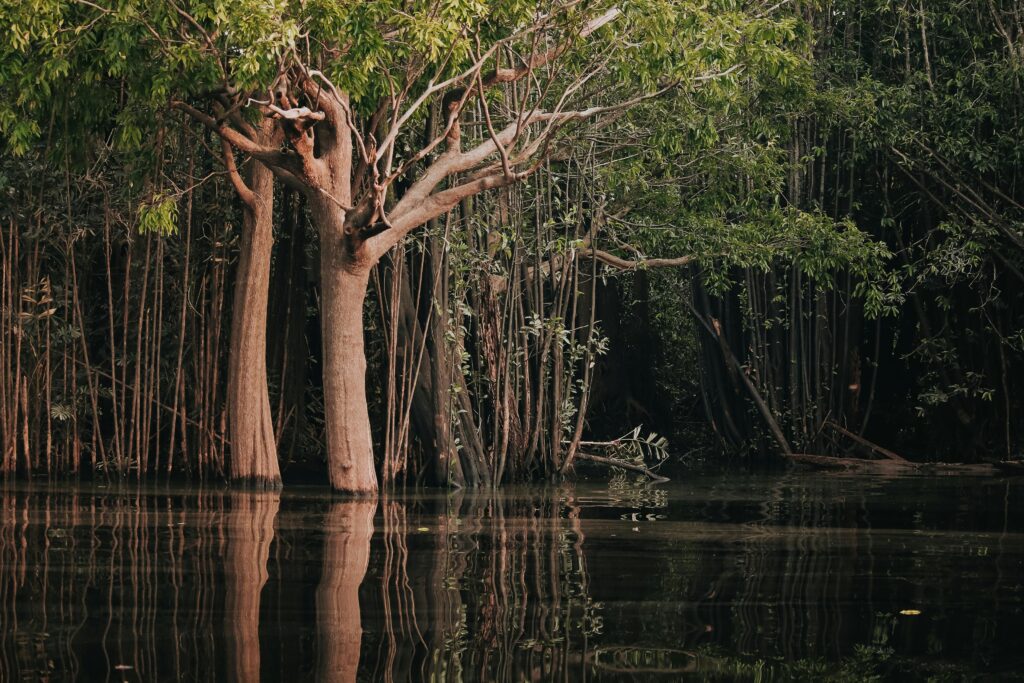Cichlids hold a special place in the aquarium hobby, captivating enthusiasts with their vibrant colors, dynamic behaviors, and remarkable adaptability. Spanning more than 1,700 recognized species and countless unique traits, these fish offer endless fascination for scientists and aquarists alike. Whether you’re mesmerized by the bold patterns of African mbuna or the graceful beauty of South American discus, the world of cichlids is as diverse as it is intriguing.
Yet, defining what makes a cichlid can be surprisingly challenging. These fish thrive in a wide array of habitats, from the rift lakes of Africa to the Amazon’s winding rivers. Their appearance, diet, and behavior vary so much that you might struggle to believe they belong to the same family. This article explores what sets cichlids apart, the fascinating traits that unite them, and why they continue to be a favorite among hobbyists worldwide.

Stunning Cyphotilapia frontosa “Mpimbwe Blue” from Lake Tanganyika showcasing its vivid blue coloration and iconic forehead hump. Photo: Fredrik Hagblom
A Family Spanning the Globe
The family Cichlidae is one of the largest vertebrate families, with species inhabiting three continents: Africa, the Americas, and parts of Asia. While African cichlids dominate the aquarium trade with their striking colors and dramatic personalities, South American species like discus and angelfish are equally iconic, celebrated for their elegance and intricate behaviors.
Take, for instance, the dazzling Symphysodon aequifasciatus, better known as the discus fish. This species glides gracefully through the calm waters of South America, where it blends seamlessly into its leafy, submerged surroundings. Contrast that with the rugged Pseudotropheus zebra, a fierce protector of rocky territories in Lake Malawi. Both are cichlids, yet their adaptations make them seem worlds apart.
The habitats cichlids occupy span a variety of conditions. From the clear waters and rocky shores of Lake Tanganyika to the murky floodplains of the Amazon basin, these fish have evolved to survive in vastly different environments. Some thrive in brackish water estuaries, like the Mayan cichlid, which can even breed in saltwater conditions, while others prefer the tranquil vegetation-filled waters of tropical rivers.

A breathtaking view of the Amazon River winding through lush tropical rainforest, showcasing its vastness and natural beauty. Photo: Tom Fisk
Spotting the Real Deal: Key Features of Cichlids
Cichlids are distinguished by several unique traits, some of which are hidden beneath their scales:
- The Fused Dorsal Fin. A hallmark of cichlids is their singular dorsal fin, divided into a spiny front section and a softer rear section. In contrast, many fish have two separate dorsal fins.
- One Nostril Per Side. Unlike most fish that have two nostrils on each side of their head, cichlids sport a single nostril per side. This peculiar feature remains a subject of scientific curiosity.
- A Split Lateral Line. The lateral line, a sensory organ running along their body, is divided into two distinct sections. This allows cichlids to detect subtle changes in water pressure—a vital skill in their often-complex habitats.
These physical traits are the foundation of their identity, but the story of cichlids goes far beyond anatomy.
Adapting to Diverse Habitats
Cichlids’ adaptability is one of their defining traits. They have evolved to exploit nearly every freshwater habitat available, from the still, sandy-bottomed shallows to the fast-moving torrents of mountain streams. In Africa’s Rift Valley lakes—Malawi, Tanganyika, and Victoria—cichlids occupy incredibly specific ecological niches, often sharing territories with dozens of other species. These lakes are a treasure trove of biodiversity, with Lake Malawi alone hosting more than 800 unique species.
In South America, the landscape shifts dramatically depending on the season. Flooded forests and vast river systems like the Amazon present cichlids with challenges and opportunities. Species like Apistogramma have adapted to live among submerged roots and plants during flood seasons, while others, like the geophagus cichlids, sift through sandy substrates to find hidden morsels of food.
Even in extreme environments, cichlids demonstrate remarkable resilience. In Nicaragua’s volcanic crater lakes, small, isolated populations have evolved unique traits to match their surroundings. Similarly, species like Vieja maculicauda inhabit coastal regions, showcasing their ability to tolerate brackish and even marine conditions.
These habitats not only influence the physical traits of cichlids but also their behavior. For example, cichlids from fast-flowing rivers often exhibit streamlined bodies and strong swimming abilities, while those from stagnant waters may rely more on camouflage and stealth to survive. The diversity of these adaptations underscores the evolutionary ingenuity of the family.
Suggested Product: Aquarium-safe substrate and rock decorations (e.g., crushed coral or limestone for African cichlids).
Purpose: Helps replicate natural habitats for cichlids that thrive in rocky environments, like mbuna.
The Marvel of Rift Valley Cichlids
No discussion of cichlids would be complete without highlighting the incredible diversity found in Africa’s Rift Valley lakes—Malawi, Tanganyika, and Victoria. These lakes, formed by tectonic activity millions of years ago, are not only geological wonders but also evolutionary hotspots. Rift Valley cichlids have undergone explosive speciation, creating some of the most dazzling and varied fish communities in the world.
Lake Malawi: A World of Color
Lake Malawi is perhaps the most famous of the three Rift Valley lakes, boasting over 800 species of cichlids, many of which are endemic—found nowhere else on Earth. These fish have adapted to highly specific ecological niches. For example, the algae-grazing mbuna live among rocky outcrops, where they use their specialized teeth to scrape food from surfaces. In contrast, species like Dimidiochromis compressiceps patrol open waters, preying on smaller fish with speed and precision.
What makes Lake Malawi’s cichlids particularly fascinating is their vibrant coloration. These fish use their bold patterns not only to attract mates but also to establish territories and intimidate rivals. Male mbuna, for instance, display intense blues, yellows, and reds, signaling their dominance to competitors and readiness to potential mates. This visual communication adds an extra layer of complexity to their behavior, making them endlessly engaging for aquarists and researchers alike.
Suggested Product: High-quality algae wafers or feeding clips for herbivorous cichlids like Tropheus or mbuna.
Purpose: Provides essential nutrients while mimicking their grazing behavior.

The pristine shoreline of Lake Tanganyika, home to a diverse array of aquatic life and stunning natural beauty. Photo: Alexandra Mamaeva
Lake Tanganyika: The Ancient Sanctuary
Lake Tanganyika, the oldest of the Rift Valley lakes, has a history stretching back around 9 million years. Its cichlid population reflects this ancient lineage, with over 250 species exhibiting a remarkable variety of shapes, sizes, and behaviors. From the shell-dwelling Neolamprologus multifasciatus, which thrives in discarded snail shells, to the predatory Altolamprologus compressiceps, which ambushes prey with precision, Tanganyika’s cichlids showcase some of the most specialized adaptations in the animal kingdom.
What sets Tanganyika apart is not just its biodiversity but also its stable environment. The lake’s immense depth and consistent conditions have allowed species to evolve elaborate social structures and unique feeding strategies. For example, Cyprichromis leptosoma forms large, shimmering schools in open water, while the Tropheus genus has developed strong jaws for scraping algae from rocks. This diversity makes Tanganyika a living laboratory for evolutionary biology.
Lake Victoria: A Rapid Evolutionary Experiment
While Lake Victoria is younger than its Rift Valley counterparts—formed roughly 15,000 years ago—it has become an iconic example of rapid speciation. Its cichlid population evolved at breakneck speed, adapting to a wide range of ecological roles in a relatively short time. Unfortunately, this evolutionary success story is also one of fragility. Introduced species like the Nile perch and environmental changes have decimated many of Victoria’s cichlid populations, making conservation efforts critical.
Despite these challenges, Lake Victoria remains a symbol of cichlid resilience and adaptability. Species like Haplochromis nyererei continue to captivate aquarists with their vibrant colors and complex behaviors, serving as reminders of the lake’s rich biodiversity.

The vibrant Protomelas fenestratus, a striking cichlid species native to Lake Malawi, known for its unique pattern and coloration. Photo: Fredrik Hagblom
Rift Valley Cichlids in the Aquarium Hobby
Rift Valley cichlids are staples of the aquarium trade, beloved for their vivid colors, engaging behaviors, and unique environmental needs. Their territorial nature and need for specific water parameters can pose challenges, but for those willing to invest the time, they offer unparalleled rewards. Whether it’s the electric blues of a Sciaenochromis fryeri from Malawi or the intricate social hierarchies of Tanganyikan shell-dwellers, Rift Valley cichlids bring a slice of Africa’s aquatic diversity into homes worldwide.
Suggested Product: High-quality filter systems or lighting setups for maintaining stable water parameters in cichlid tanks.
Purpose: Vital for replicating their natural environments and ensuring water quality.
Feeding Strategies: Masters of Adaptation
Cichlids’ feeding habits are as varied as their habitats. Some, like Tropheus from Lake Tanganyika, specialize in grazing on algae, using their robust jaws and fine teeth to scrape surfaces clean. Others, like the carnivorous Cichla temensis from South America, are open-water predators that rely on speed and precision to hunt smaller fish. This dietary diversity is a testament to the family’s adaptability.
Interestingly, some cichlids have evolved highly specialized diets. For example, scale-eaters like Perissodus microlepis from Lake Tanganyika remove scales from other fish with swift, precise movements—a behavior unique to their environment. Similarly, paedophagous cichlids feed on the fry of other species, taking advantage of their abundance during breeding seasons.
Omnivorous cichlids, such as the convict cichlid (Amatitlania nigrofasciata), can thrive in a wide range of conditions thanks to their flexible diets. This adaptability makes them popular among aquarists, as they are easy to feed and care for.
In Lake Malawi, dietary specialization has reached extraordinary levels. Certain species, like Labidochromis caeruleus, nibble exclusively on invertebrates nestled among rocks, while others, such as Labeotropheus trewavasae, focus on scraping algae. This dietary segmentation helps reduce competition and ensures a balanced ecosystem, showcasing the intricate relationships within these habitats.
Suggested Product: Frozen or freeze-dried food for carnivorous cichlids (e.g., brine shrimp or krill).
Purpose: Supports the dietary needs of predatory species like Cichla temensis.
Suggested Product: Balanced pellet food enriched with vitamins for omnivorous cichlids like convict cichlids. Purpose: Ensures a diverse diet to keep them healthy in captivity.

Geophagus megasema ‘Rio Tapajos,’ a stunning South American cichlid renowned for its striking coloration and sand-sifting behavior. Photo: Fredrik Hagblom
Evolutionary Marvels
Cichlids are often described as “nature’s evolutionary experiment,” and nowhere is this more evident than in Africa’s Rift Valley lakes. Here, isolated populations have undergone rapid speciation through a process known as adaptive radiation. This occurs when species diversify quickly to fill available ecological niches, leading to the extraordinary diversity seen today.
Lake Victoria, for instance, is home to hundreds of cichlid species that have evolved to exploit specific food sources. Some have developed long, narrow mouths for picking at algae, while others possess strong, crushing jaws for consuming snails. These adaptations not only highlight their versatility but also demonstrate the power of natural selection in shaping biodiversity.
In South America, the Amazon basin provides a different kind of evolutionary playground. The ever-changing landscape of rivers, floodplains, and seasonal droughts has forced cichlids to become masters of survival. Species like Satanoperca sift through the substrate for food, while discus and angelfish have evolved laterally compressed bodies to navigate dense underwater vegetation and avoid predators.
The evolutionary flexibility of cichlids is so impressive that they have become a model for studying speciation and adaptation. Scientists continue to explore their genetics, behavior, and ecological roles to better understand how these fish have become so successful.
The Role of Cichlids in Aquatic Ecosystems
Beyond their appeal in aquariums, cichlids play vital roles in maintaining the balance of their natural ecosystems. In African lakes, herbivorous cichlids control algae growth, preventing overgrowth that could harm water quality. Carnivorous species, on the other hand, regulate populations of smaller fish, ensuring a balanced food web.
Cichlids also act as ecosystem engineers. By digging nests, sifting through sediment, or feeding on specific organisms, they influence the physical and biological structure of their habitats. This behavior creates opportunities for other species to thrive, underscoring their importance in maintaining biodiversity.
Unfortunately, many wild cichlid populations face threats from habitat destruction, pollution, and overfishing. Conservation efforts are essential to preserving their unique ecosystems and ensuring that these remarkable fish continue to thrive for generations to come.

A close-up of an Amazon riverbed, a typical cichlid habitat with submerged tree roots and dark, tannin-stained water. Photo: Jean GC
Why Cichlids Matter
Cichlids are much more than aquarium fish—they are ambassadors of biodiversity, symbols of adaptation, and a source of endless fascination. Their vibrant colors, complex behaviors, and ecological significance make them a cornerstone of the natural world and a beloved companion for aquarists.
Whether you’re captivated by the territorial displays of African mbuna, the serene beauty of a discus, or the predatory prowess of an open-water hunter, cichlids offer a unique glimpse into the wonders of aquatic life. For aquarists, they provide endless opportunities to learn, observe, and appreciate the intricacies of evolution and ecology.
Conclusion
For those who keep them, cichlids are not just pets but windows into the mysteries of the natural world. Their diversity, adaptability, and captivating behaviors make them a testament to the wonders of evolution and a reminder of the delicate balance of life beneath the water’s surface.
Related reading
